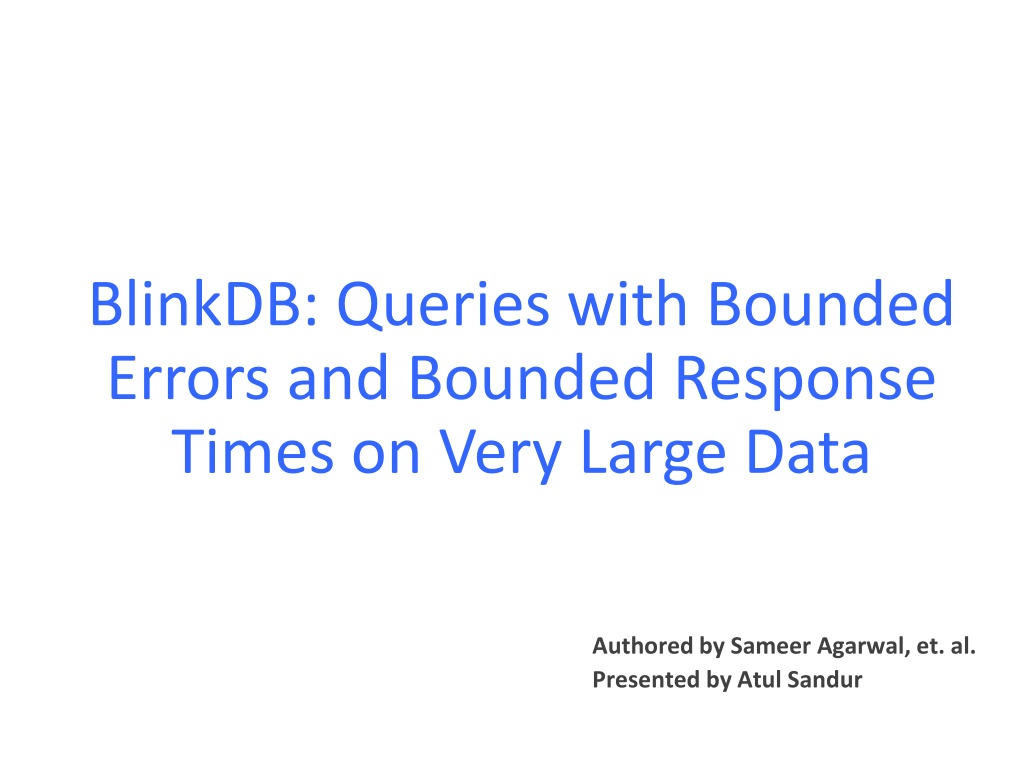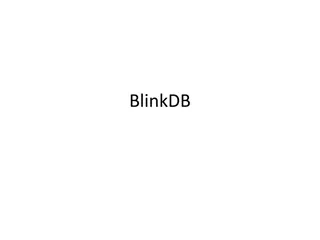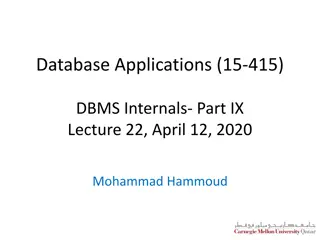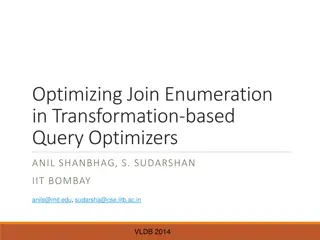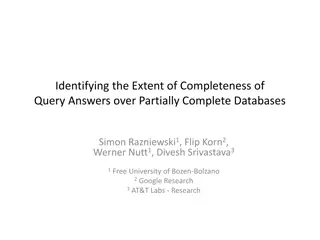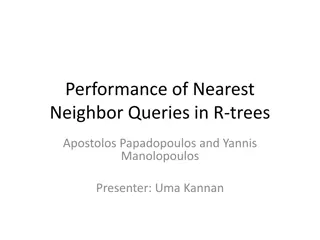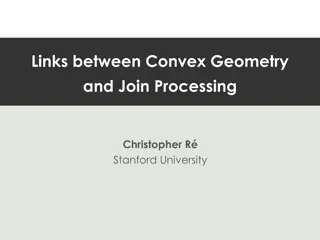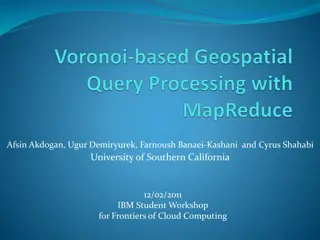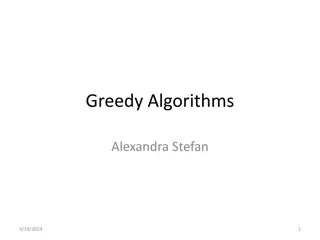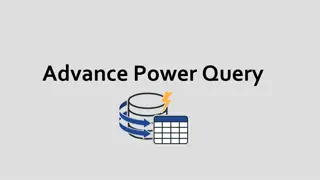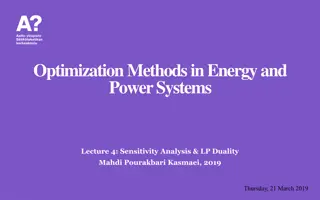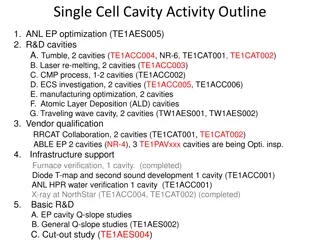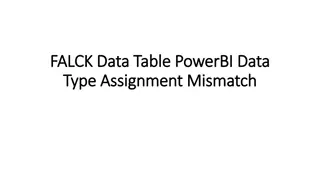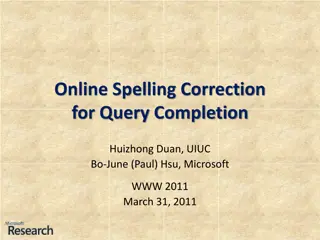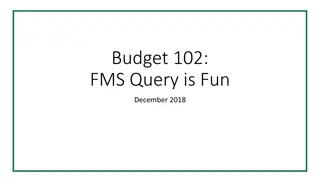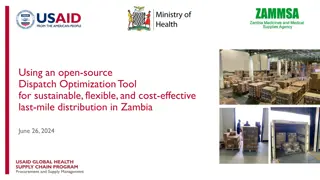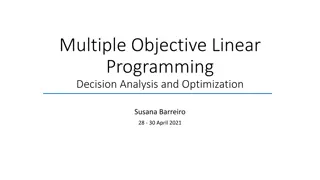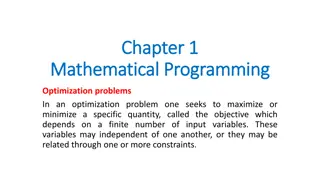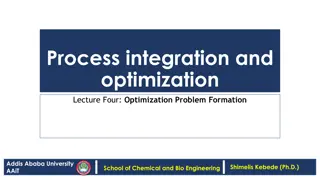Overview of BlinkDB: Query Optimization for Very Large Data
BlinkDB is a framework built on Apache Hive, designed to support interactive SQL-like aggregate queries over massive datasets. It creates and maintains samples from data for fast, approximate query answers, supporting various aggregate functions with error bounds. The architecture includes modules for sample selection, query planning with error constraints, and sample creation based on query patterns. By pre-computing samples for predictable workloads and leveraging closed-form error estimation, BlinkDB enables efficient query processing on very large data sets.
Download Presentation

Please find below an Image/Link to download the presentation.
The content on the website is provided AS IS for your information and personal use only. It may not be sold, licensed, or shared on other websites without obtaining consent from the author. Download presentation by click this link. If you encounter any issues during the download, it is possible that the publisher has removed the file from their server.
E N D
Presentation Transcript
BlinkDB: Queries with Bounded Errors and Bounded Response Times on Very Large Data Authored by Sameer Agarwal, et. al. Presented by Atul Sandur
Motivation Traditional SQL queries Can we support interactive SQL-like aggregate queries over massive datasets? 2
Motivation 100 TB on 1000 machines - 1 Hour 1 - 5 minutes 1 second ? Query execution on samples of data 3
Query Execution on Samples What is the average latency in the table? ID City Latency 1 NYC 30 ID City Buff Ratio Sampling Rate 2 NYC 38 3 SLC 34 2 NYC 38 1/2 4 LA 36 3 SLC 34 1/2 Uniform Sample 5 SLC 37 5 SLC 37 1/2 6 SF 28 7 NYC 32 1/2 7 NYC 32 8 NYC 38 1/2 8 NYC 38 12 LA 34 1/2 9 LA 36 Full data: 34.667 Rate : 32.33 2.18 Rate : 35.5 1.02 10 SF 35 11 NYC 38 12 LA 34 4
What is BlinkDB? A framework built on Apache Hive that - Creates and maintains a variety of uniform and stratified samples from underlying data (offline) - Returns fast, approximate answers by executing queries on samples of data selected dynamically (online) - Compatible and integrated with Apache Hive, supports Hive s SQL style query structure 5
Design considerations Query-column-set (QCS): Appears in query filtering/groupby clause, data expected to be stable over time Targets predictable query-column-set (QCS) style workloads Enables pre-computing samples that generalize to future workloads 6
Queries Supports COUNT, AVG, SUM and QUANTILE Relies on closed form error estimation for these aggregates Can be annotated with error bound/time constraint Selects appropriate sample type and size 7
High level architecture Sample selection module Updated Query plan Query with error/latency bound Query plan Execute Uniform Sample creation module Stratified on C1 Table Stratified on C2 8
Sample creation (uniform) ID City Latency ID City Latency Weight 1 NYC 30 2 NYC 38 1/3 4 2 NYC 38 6 SF 28 1/3 3 SLC 34 8 NYC 38 1/3 4 LA 36 12 LA 34 1/3 5 SLC 37 U 6 SF 28 1. 2. 3. FILTERrand() < 1/3 Adds per-row Weights (Optional) ORDER BY rand() 7 NYC 32 8 NYC 38 3 9 LA 36 10 SF 35 11 NYC 38 1 2 12 LA 34 9
Sample creation (stratified) ID City Latency 4 1 NYC 34 2 NYC 32 3 SF 36 City Count Ratio 4 NYC 28 JOIN S2 NYC 7 2/7 5 NYC 37 S2 SF 5 2/5 6 SF 33 SPLIT S1 GROUP 7 NYC 31 8 NYC 30 9 SF 32 3 10 SF 34 11 NYC 35 12 SF 36 1 2 10
Sample creation (stratified) 4 ID City Data Weight 2 NYC 32 2/7 U 8 NYC 30 2/7 6 SF 33 2/5 S2 12 SF 36 2/5 S2 S1 3 1 2 11
Sample creation (stratified) Uniform sampling wouldn t work if queries include filtering, groupBy, etc. Rare subgroups require large samples for high confidence estimates Uniform sampling may miss subgroups Error decrease slows down with increasing sample size Assign equal sample size to each group Sample size assignment is deterministic Aggregate standard error 1/ ? (K is per group cap on sample count) Stratified sample size per group 12
Sample creation for multiple queries Multiple queries sharing QCS, different values of n (#rows to satisfy query) Sample depends on n (error/time bound) and selectivity of query Requires maintaining one sample per family of stratified samples Sn Sample for multiple queries with shared QCS 13
Sample creation (optimization) Multi-dimensional stratified samples Objective function Weighted sum of coverage of QCSs of historical queries Storage cost for the samples Constraints Sample s coverage probability for query QCS 14
Sample selection (runtime) Selecting the sample type Query s column-set is subset of stratified sample QCS? Select, else Run query across all samples to pick ones with high selectivity Selecting sample size Error-Latency profile by running query on smaller samples Project profile for larger sample sizes Error profile Estimate query selectivity, sample variance, input data distribution Use standard closed form statistical error estimate Latency profile: Assumes latency scales linearly with input size 15
Evaluation Conviva error comparison BlinkDB vs. No sampling Expected error minimized TPC-H error comparison 16
Evaluation Relative error bounds Response time bounds Smaller sample sizes Low communication cost Scaleup 17
Conclusion Sampling based approximate query engine that supports query error and response time constraints Uses multi-dimensional stratified sampling with runtime sample selection strategy Can answer queries within 2 seconds on upto 17 TB of data with 90-98% accuracy 18
Thoughts Novel concepts introduced with grounding in statistics/sampling theory to build upon Can be integrated to existing query processing frameworks like Hive & Shark Follow up work such as supporting more generic aggregates and UDFs Potentially crucial aspects not addressed properly: M and K values are fixed, optimization space could be huge (heuristics unclear), sample replacement period, etc. What if ELP estimates are not accurate? And do we verify error estimates, query feasibility? 19
Thank you! 20
Extra slides 21
Speed/Accuracy Trade-off Enable exploring speed- accuracy tradeoff curve for performance Real time analysis Pre-existing noise from data collection already 22
Apache Hive Built on top of Hadoop to query/manage large datasets Imposes structure on variety of data formats SQL-like query language, can be extended to write UDF s Batch jobs over large sets with scalability, extensibility, fault tolerance and loose coupling with input formats 23
BlinkDB Architecture Command-line Shell Thrift/JDBC Driver Physical Plan SQL Parser Query Optimizer Meta store SerDes, UDFs Execution Hadoop/Spark/Presto Hadoop Storage (e.g., HDFS, Hbase, Presto) 24
Error Estimation Closed Form Aggregate Functions - Central Limit Theorem - Applicable to AVG, COUNT, SUM, VARIANCE and STDEV 25
Error Estimation Closed Form Aggregate Functions - Central Limit Theorem - Applicable to AVG, COUNT, SUM, VARIANCE and STDEV 26
